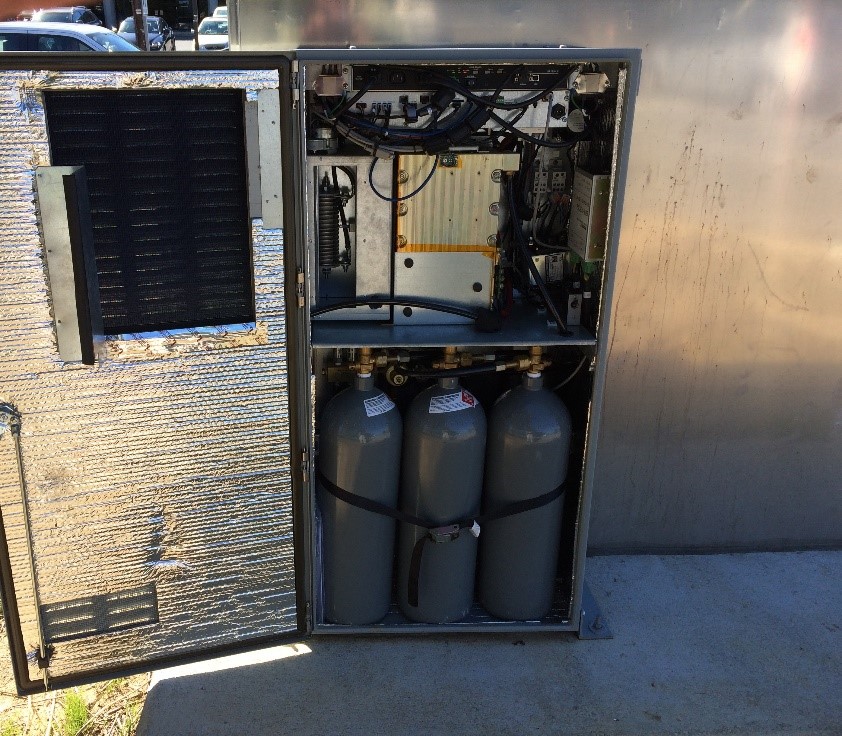Traffic Signals, Railroads, and Public Safety
Justin Lewis
Compared to other industrialized nations, the United States relies heavily on motorized transit for local and cross-country travel. However, America continues to make extensive use of its nationwide rail network to transport freight. Both transportation networks depend on signaling and communications equipment to keep vehicles and pedestrians safe. This week’s In Transitions discusses how hydrogen fuel cells can help ensure these crucial machines stay up and running when natural disasters and other emergencies shut down the electric grid.
Traffic signals are a ubiquitous fixture of society, helping to facilitate the safe flow of vehicles and pedestrians across our country’s roads. However, with most municipal networks relying on the electric grid for their primary power, traffic signals are highly susceptible to blackouts caused by natural and manmade disasters. Recent catastrophic weather events in the United States demonstrate this. After Hurricane Irma hit Florida in September of 2017, power outages shut down large swaths of traffic lights in Broward, Palm Beach, and Miami-Dade Counties, taking days to repair and causing numerous accidents. The same safety issues occurred after Hurricane Florence hit the Carolinas this September – nearly every traffic light in Wilmington, North Carolina, went dark, with signal outages reported as far south as Myrtle Beach, South Carolina.
In addition to weather events, our country’s aging and overburdened grid infrastructure ensures that traffic signal outages will become even more common. While state and local governments traditionally use diesel or battery backup generators to mitigate these dangers, communities are also turning to hydrogen fuel cells as a promising solution. Fuel cell backup power technologies provide longer runtimes and require fewer maintenance requirements than diesel generators, while mitigating noise and environmental pollution associated with these systems.
FCHEA member Altergy is an industry leader in this application, with their 1-kilowatt Freedom Power Traffic Signal Platform (TSP) being deployed in towns across America today. Altergy’s fuel cell solutions also provide backup power for critical public safety technologies that can’t depend on the grid or unreliable generators during natural disasters and other emergencies.
TSP deployment (bottom left) in Folsom, California. Source: Altergy
While fuel cell backup power for traffic signals is primarily a West Coast innovation, the East Coast is beginning to catch up. In the summer of 2017, Alexandria, Virginia, became the first East Coast city to use a hydrogen fuel cell as a backup power source for traffic lights. Through the city’s Hydrogen Fuel Cell Traffic Signal Pilot, the heavily-trafficked intersection that connects King Street, Quaker Lane, and Braddock Road now has a reliable, green-energy backup for traffic signals to remain in operation without interruption. According to the city government, the pilot was spurred by fuel cell technology’s cost savings, reliability and reduced maintenance compared to traditional battery backup systems. City leaders plan to expand the pilot to additional intersections in the coming years, as fuel cell costs continue to decrease.
The King/Quaker/Braddock intersection hydrogen fuel cell backup generator.
Source: The City of Alexandria
Just like traffic signals ensure safe passage on roadways, signaling and switching equipment helps keep our country’s 212,000 miles of rails remain safe and efficient. Once again, fuel cells help protect this vital infrastructure during grid outages by providing clean, resilient, and efficient power for rail sensor equipment and railroad telecommunications networks.
Both Altergy and FCHEA member Plug Power provide fuel cell backup generators for a number of railroad customers, such as CSX, one of the largest rail networks in eastern North America. Both companies’ fuel cell products ensure reliable, clean, and cost-effective backup and off-grid power for many railroad applications such as crossings, switchers, positive train control sensors, and more. In 2014, CSX had more than 200 deployed.
A Plug Power GenSure fuel cell backup power generator (left) on a stretch of CSX railroad. Source: Plug Power
Whether it’s to keep the flow of traffic safe during a hurricane, provide communications for public safety services during an emergency, or maintain the orderly transit of trains across railroad networks, fuel cells serve as a green, resilient backup power source for state and local governments.



